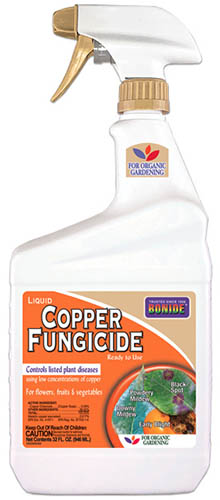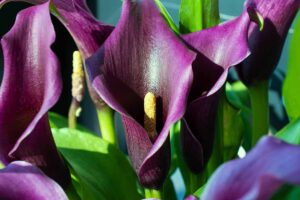Orchids are magical. The ostentatious flowers are tailor-made to attract all the pollinators, with the added bonus of attracting us humans.
We gardeners spend so much time cultivating and propagating them, all for those incomparable blossoms.
It’s devastating when your orchids have problems that cause them not to flower or for the leaves to turn yellow, brown, wrinkled, or wilted. They’re just too pretty to let that happen.
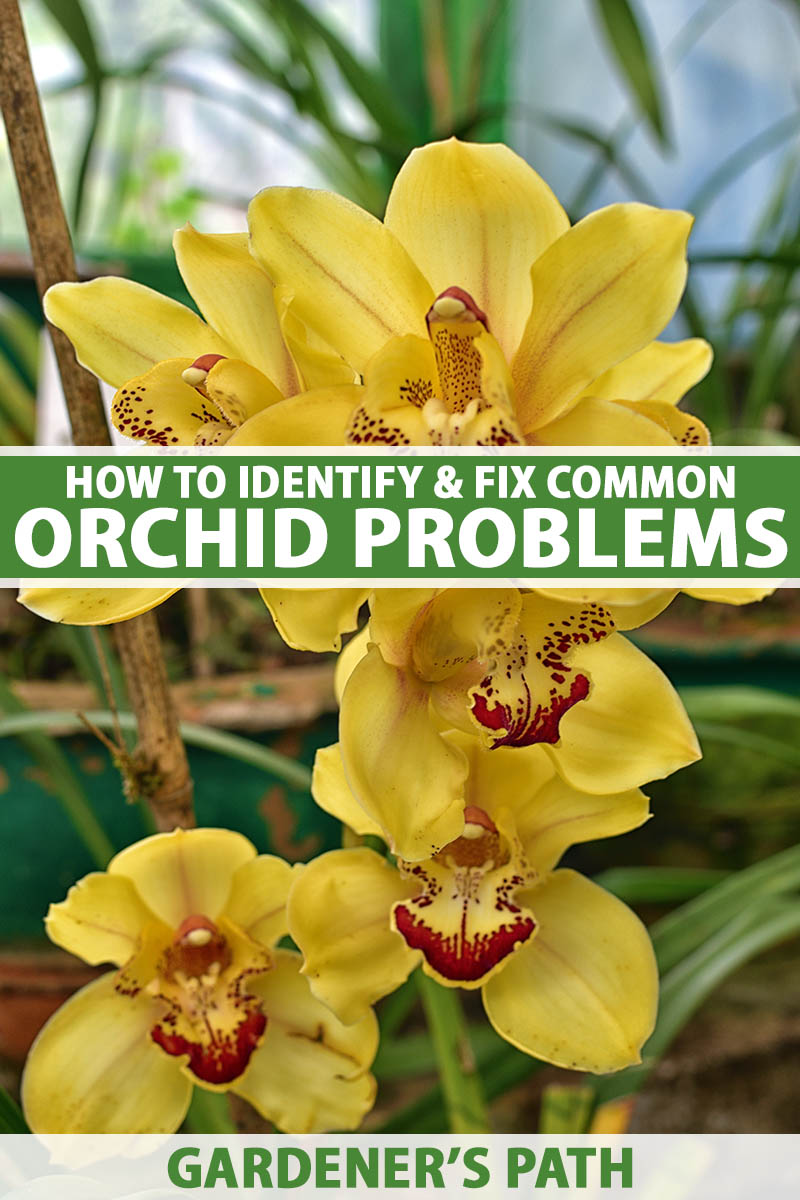
We link to vendors to help you find relevant products. If you buy from one of our links, we may earn a commission.
Sadly, orchids can be a bit temperamental. No wonder a lot of people just enjoy them while they bloom and then toss them when they’re done.
But if you want to keep your orchid for years to come, then you’ll need to know what to watch for and how to address it if a problem happens.
If something doesn’t look right with your orchid, do your absolute best to figure it out right away.
Without exception, the faster you identify a problem and start addressing it, the better your chances of fixing your orchid.
Let’s start with the one issue you can identify solely with your nose:
1. Bad Smell
If your orchid has brown spots on the leaves accompanied by a bad smell that might remind you of fish left out on the counter for too long, it’s likely suffering from bacterial spot.
If the smell is accompanied by water-soaked lesions on the foliage, you can be sure.
Bacterial spot is caused by Erwinia spp. and Acidovorax spp., and spreads far too easily.
It can be carried on tools, your skin, your gloves, in splashing water or rain, or even in the droplets of a humid environment.
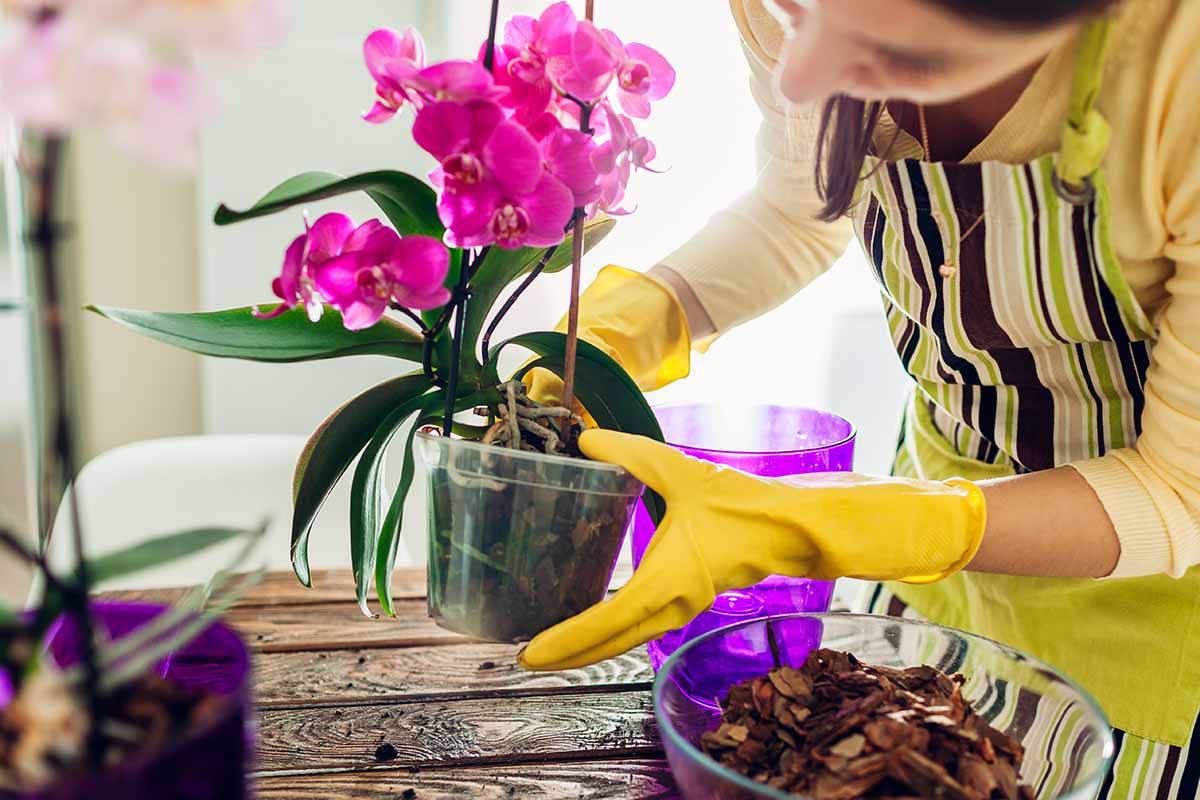
Unfortunately, once the orchid is infected, there is no cure, and the bacteria is in the plant’s system – it’s systemic – so you can’t just cut off the symptomatic areas and hope it will go away.
You’ll need to dispose of the orchid so the disease doesn’t spread, and then, in the future, be super careful about gardening hygiene and watering practices.
2. Brown Leaf Tips
If just the ends of your orchid’s foliage are brown and crispy, it’s likely that you’ve either overfed your plant or you’ve been using municipal water, which contains minerals that can build up in the soil and burn the roots.
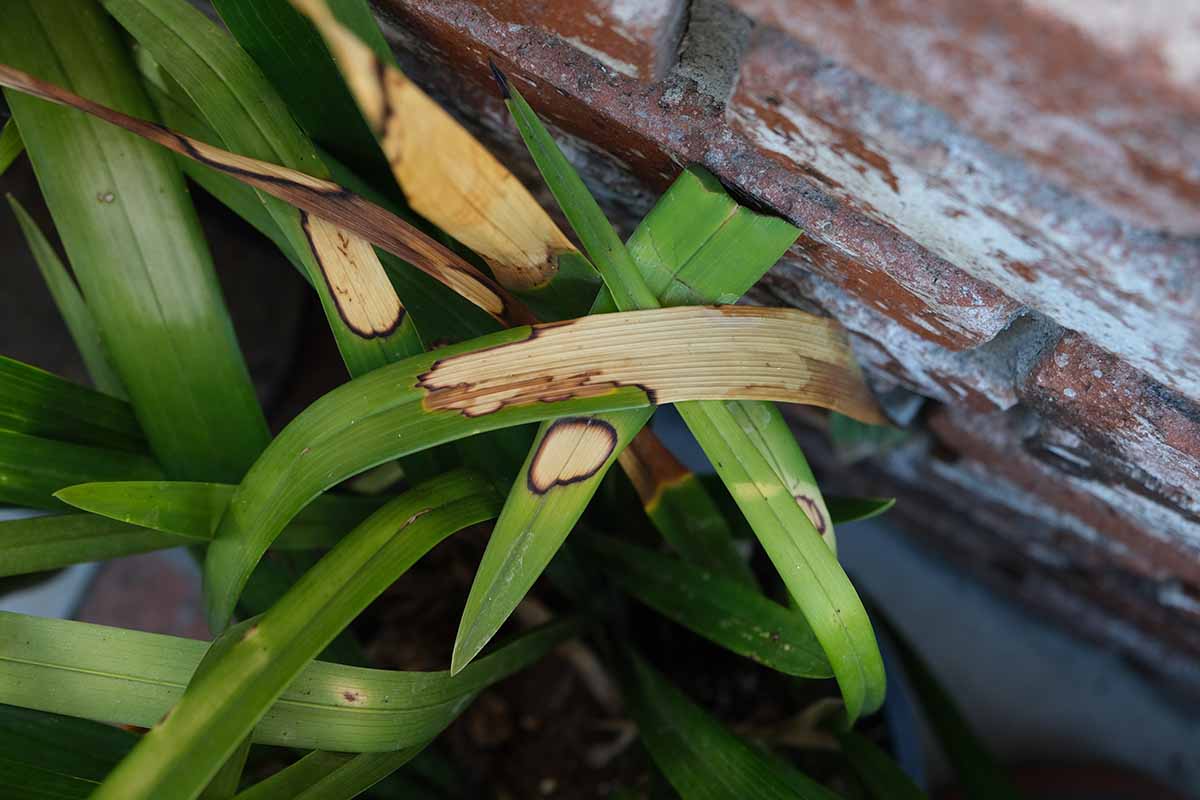
It’s best to fertilize frequently with diluted, low-strength fertilizer than to feed less often with a strong fertilizer.
Most species can be fed biweekly at quarter strength with a standard liquid 3-3-3 or 4-4-4 NPK fertilizer.
You should also try to use rainwater, distilled water, or filtered water if you can. If not, flush the potting medium every few months to remove the mineral buildup.
Sometimes, you can tell that salt has built up in the medium by the whitish, cream, or brownish crust that can develop on the surface of the substrate.
If you see this crust in the drainage pot, you can be sure your water has minerals in it.
Learn more about watering orchids in our guide.
3. Brown Leaves and Pseudobulbs
Even brief exposure to temperatures in the 30s can cause cold injury, and even if the leaves aren’t covered in frost, low temperatures can harm orchids.
Some species can tolerate some cold stress, but others can’t abide even a whiff of a chill.

The leaves and pseudobulbs will look dark, dry, or might have water-soaked spots. Most often, the symptoms start developing during the cold exposure, but some might not show up until after temperatures have warmed up.
Don’t assume that because your orchid is growing indoors that cold injury can’t happen.
If you keep your plant near an exterior door or a single-pane window, the temperatures can become cold enough to damage your orchid. That’s because single-pane windows don’t provide much insulation, so cold air can seep in and harm nearby plants.
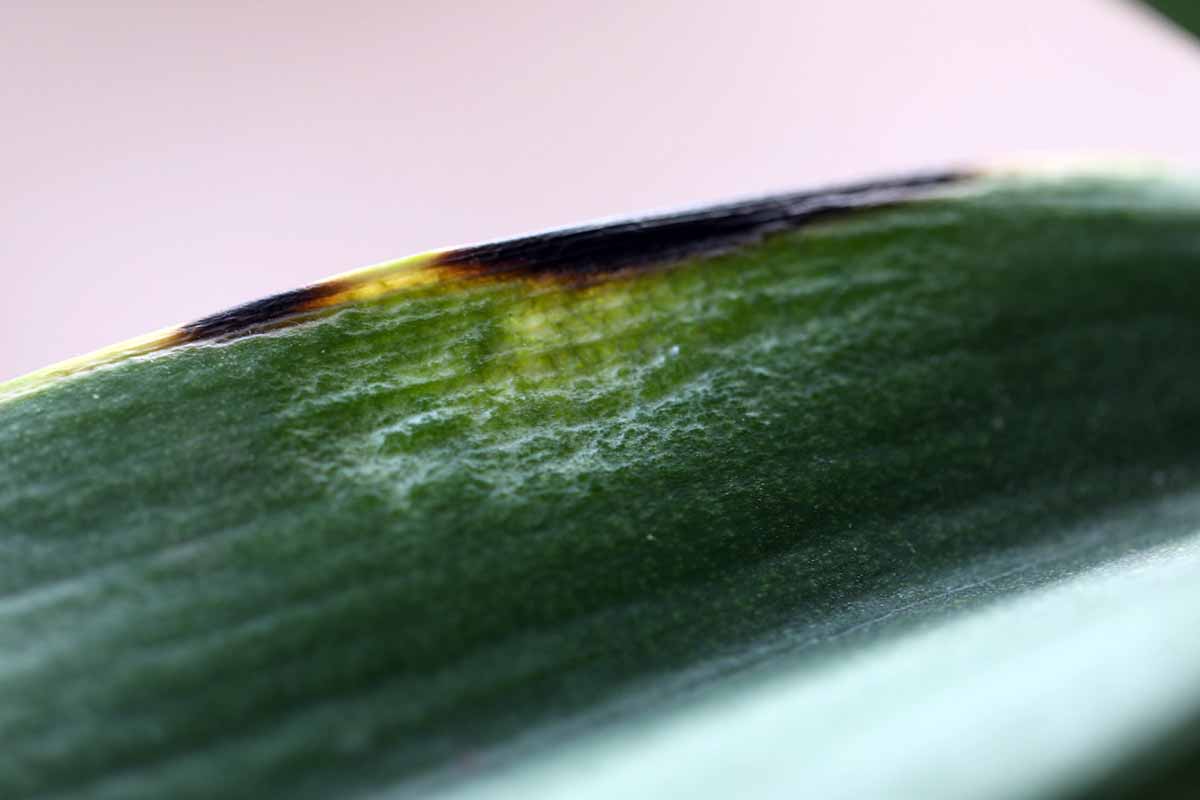
Orchids kept outdoors should be covered during a cold snap, and those indoors should be kept away from drafty windows or doors.
Any dead or severely damaged areas need to be pruned off because they won’t recover. But so long as the roots weren’t harmed, the orchid will send out fresh, new growth.
4. Brown Sunken Splotches
When your plants are exposed to low temperatures, it causes something called mesophyll cell collapse. I hear you. You keep your orchids indoors, so there is no way this is the problem.
But if you’re one of those people who follow the advice to water your orchid with an ice cube, it could be causing the problem if the ice touches the foliage.
Anytime the orchid is exposed to temperatures below 45°F, or temperatures significantly lower than it can tolerate, for too long, you risk this problem. The result is sunken brown areas on the leaves.
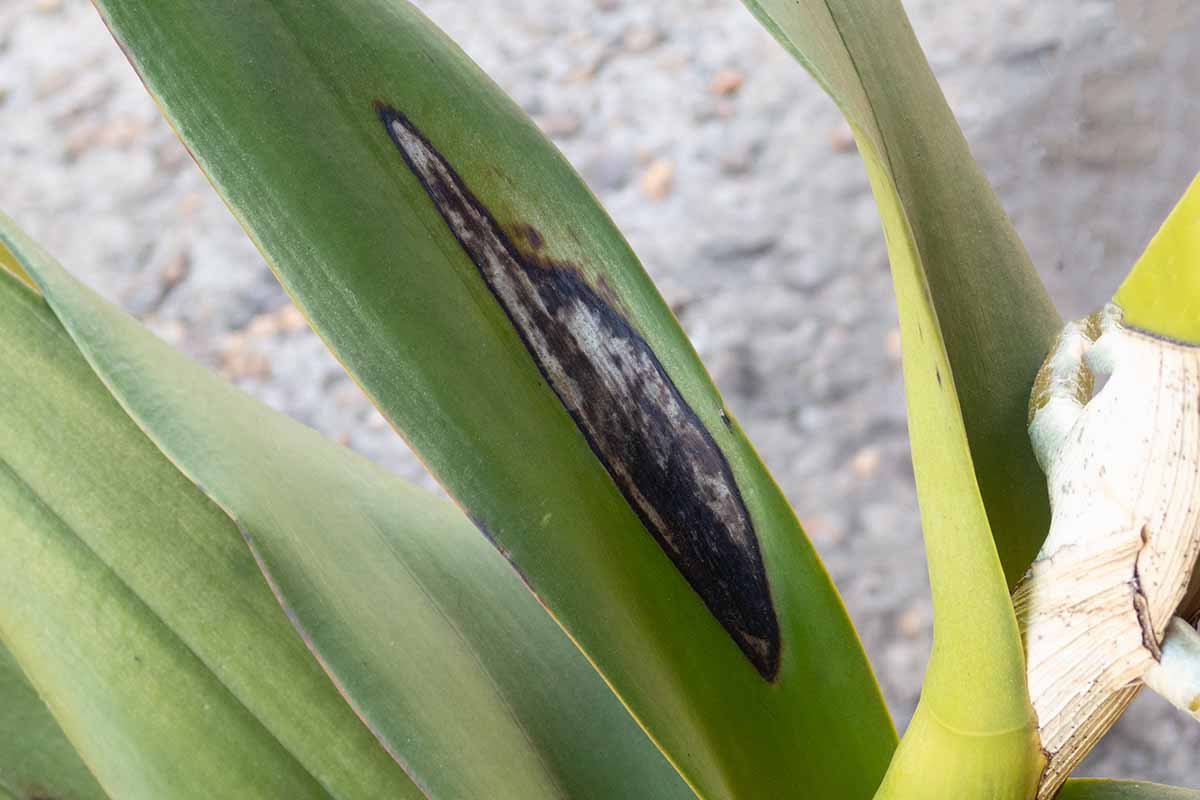
The brown, sunken spots can also be caused by a disease called anthracnose, caused by fungi in the genus Colletotrichum.
You can’t fix the damage; all you can do is avoid it. If you use the ice cube watering method, make sure to keep the ice away from the leaves. If your orchids are growing outside, bring them in or protect them with thick blankets during any unseasonal cold snaps.
These symptoms can also be caused by wiping a plant with alcohol. Isopropyl alcohol is sometimes used to kill pests like mealybugs. But alcohol evaporates rapidly, cooling the plant quickly.
If you opt to use alcohol to kill pests, don’t wipe it on the plant itself. Apply it directly onto the pests.
If you know your orchid hasn’t been exposed to cold temperatures, ice, or isopropyl alcohol, you can assume anthracnose is causing the problem.
In that case, trim off symptomatic leaves and spray the remaining foliage with copper fungicide.
Bonide Liquid Copper Fungicide
Arbico Organics carries Bonide Liquid Copper Fungicide in 32-ounce ready-to-use or 16-ounce concentrate containers.
5. Bud Blast
Bud blast is like a punch to the gut for any houseplant parent. You finally encouraged your orchid to send out a new flower stalk, and the little buds were forming, and then wham – the buds drop to the ground.
Buds can fall when they’re just starting to form on the stem or as new buds form beyond existing flowers.
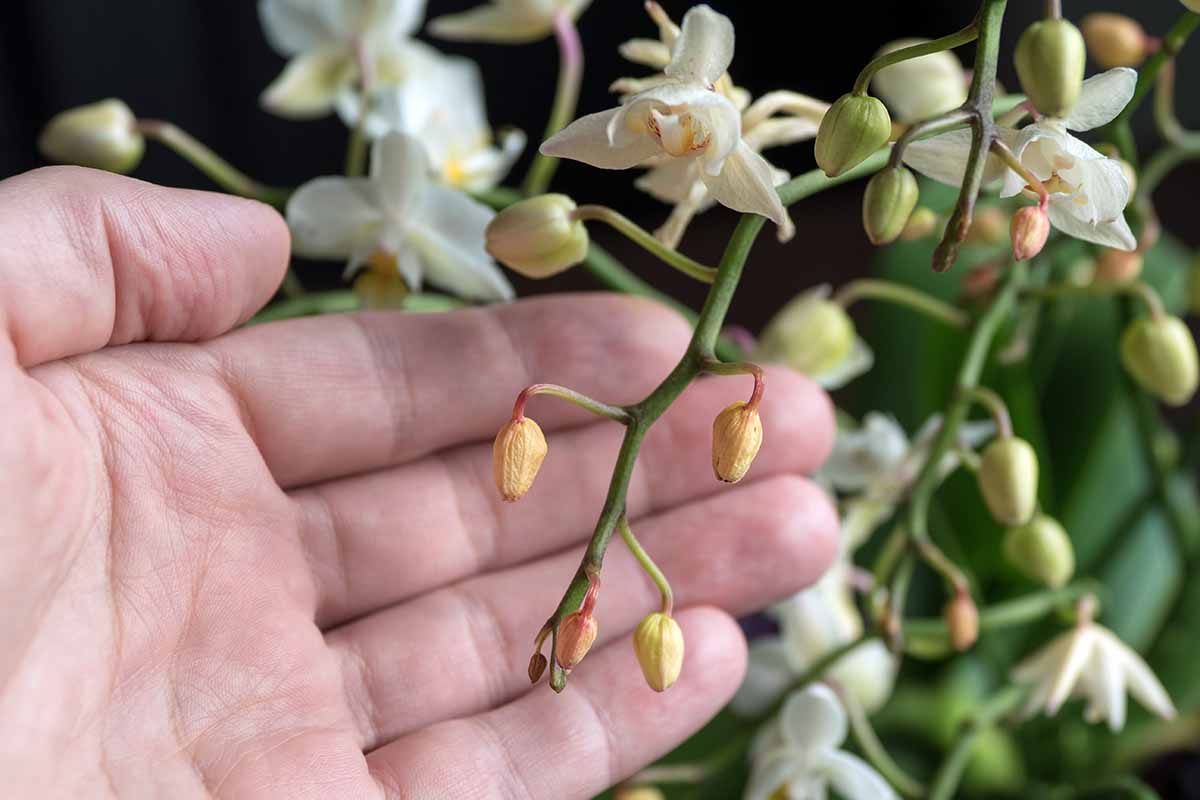
The other reason bud blast sucks so much is because there are a large number of different causes.
If environmental conditions stress the plants, they’ll toss their buds because they’re the most expendable part. That way, they can focus their energy on more important things like leaves and roots.
Over- or underwatering is a common cause, as is too little light or low humidity. If the orchid is exposed to extreme changes in temperature, that can cause it too. Even exposure to gasses like ethylene or methane can trigger bud blast.
Overfertilization, pest infestations, disease, or even orchids with bad genetic backgrounds can cause bud blast as well.
In other words, if this happens to your orchids, all you can do is try to support them and give them the appropriate growing conditions for the species.
6. Curling Leaves
Leaves that twist and curl in on themselves are stressed. Most often, this is caused by chronic underwatering.
There are some orchids, particularly cattleyas, that tend to curl for no good reason, possibly indicating that it’s genetic.
So long as the orchid is cared for properly, and you can tell for sure that the medium is appropriately moist, don’t worry about it.
The leaves might also twist to stretch toward a bright light source, which is another reason to always rotate your plants.
But in this case, the leaves won’t be curling in on themselves; they’ll merely be arcing toward the light.
7. Dropping Foliage
Generally, if the foliage starts to turn pale or yellow and drops from the plant, it’s likely that your orchid needs more nutrients.
Orchid medium can compact, break down, and become depleted over time – or maybe you forgot to fertilize your plants.
Dropping foliage can also be caused by overwatering and root rot.
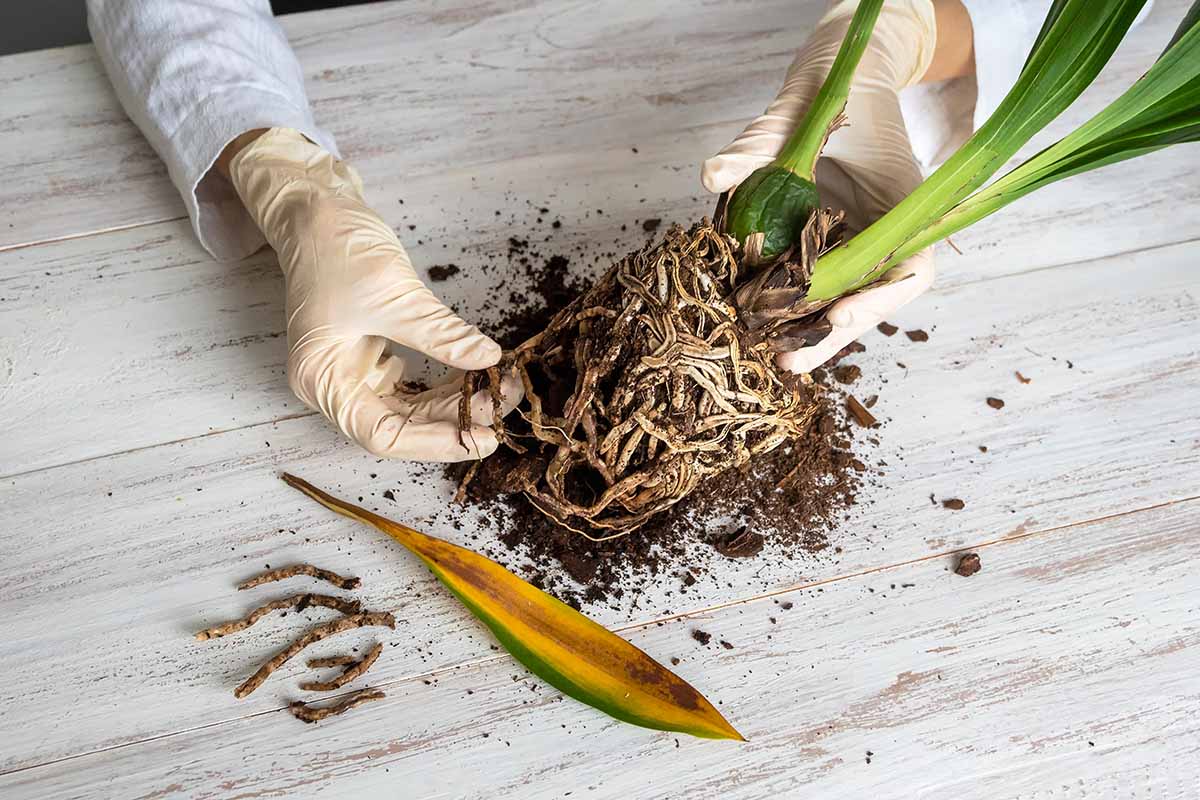
Remember that some species are deciduous and drop their leaves in the fall – this is nothing to worry about as they will develop new growth in the spring.
If you’re unsure of the cause, check the roots. If they’re black and mushy, then the problem is probably root rot. Otherwise, you can assume your orchid is hungry and give it some fertilizer.
8. Pleated Leaves
When your orchid’s leaves start to look a bit like the bellows of an accordion, it’s perplexing. Has some origami-loving gnome been secretly visiting your plant in the wee hours of the night?
Maybe.
But it’s more likely that the horizontal pleating is caused by a lack of moisture. This phenomenon is common in orchids from the Oncidium genus, which tend to have quite thin leaves.
Species with thick, fleshy leaves, like Phalaenopsis, are less commonly impacted by this problem.
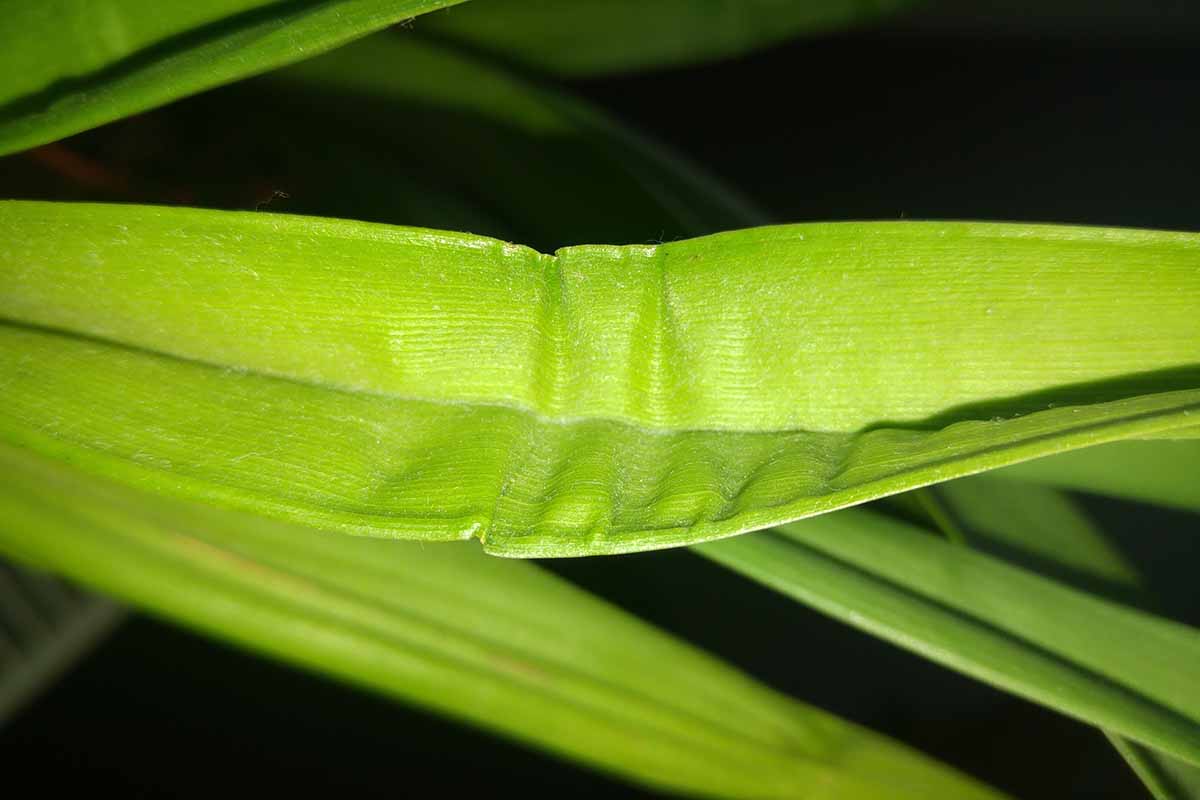
When the plant doesn’t receive enough humidity, or there is a lack of moisture in the medium, or the roots can’t take up water for some reason, the pleating may follow.
Check the roots for rot, and if you see any, trim off the rotten roots. Then, repot your orchid in fresh medium.
Learn more about how to repot orchids in our guide.
Even if you don’t see rotten roots, repot in fresh medium, since potting medium tends to compact over time, reducing the root’s access to moisture.
Either way, try to increase the humidity around the plant by using a humidifier, grouping your houseplants together, or putting the orchid in the bathroom or near the kitchen sink.
Then, increase how often you water, but be sure to let the water fully drain out. Orchids should never sit in standing water.
Keep in mind that keeping your plant under lights can also deplete moisture, causing pleated foliage.
The wrinkled leaves won’t ever straighten out, and it’s important not to try to force them, or they’ll just break. But new foliage will emerge nice and straight.
9. Spotting
Spots can appear on the leaves, buds, or flowers.
When they only appear on flowers, especially if the flowers are white or a pale hue, it’s likely botrytis (Botrytis spp.). This disease thrives in cool, humid conditions, and is especially common in greenhouses.
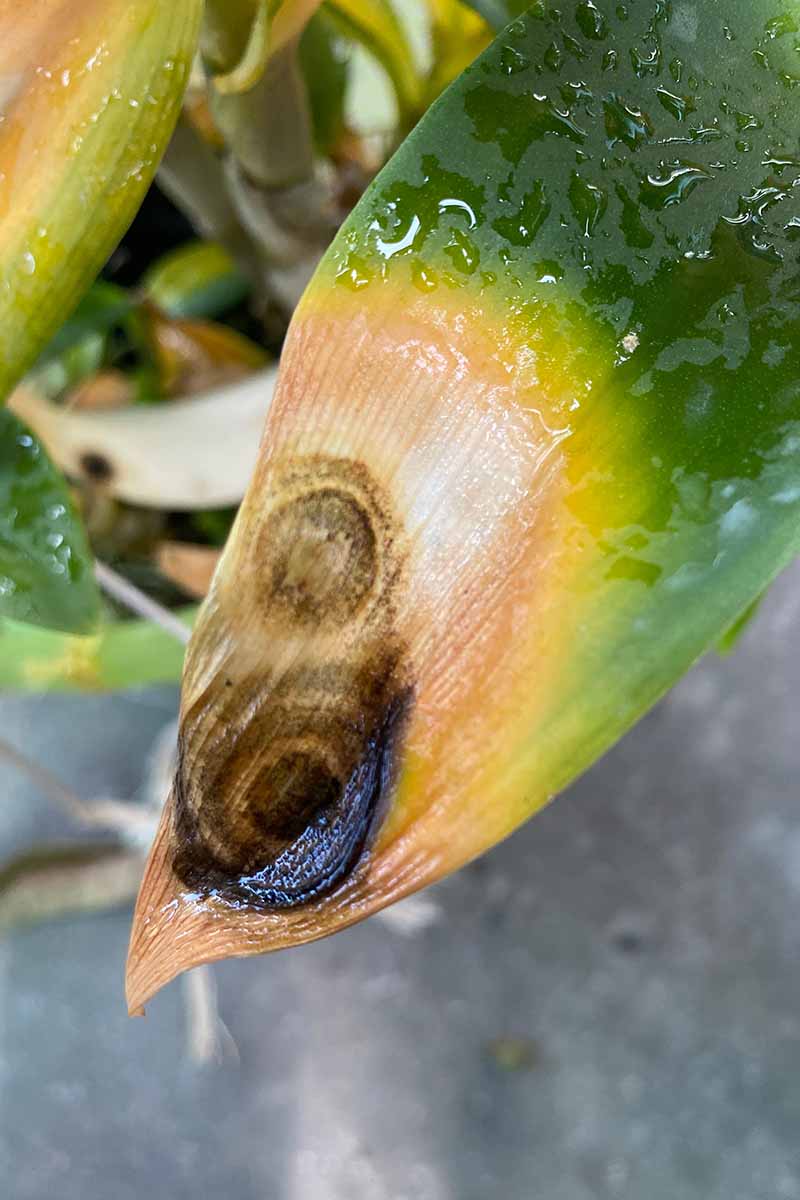
Good air circulation is key to preventing this disease, as is watering at the soil level rather than splashing the foliage or flowers. Once the disease is present, you can’t eliminate it, but you can prevent new growth from being infected.
Remove the symptomatic flowers and spray the plant with copper fungicide once a month for six months.
Phyllosticta leaf spot is caused by the fungus P. capitalensis and spreads in warm, humid weather. It causes elongated purple or black spots on the leaves. As these mature, the inside of the spot turns tan.
Symptomatic foliage should be removed, and the rest of the plant should be treated with Mancozeb.
I always keep this broad-spectrum fungicide around because it’s useful for many diseases.
You can grab a 16-ounce concentrate from Bonide via Amazon.
Large, soft, watery spots on the leaves point to issues like black rot (Pythium spp. and Phytophthora spp.), Cercospora leaf spot, or root rot.
All should be treated by reducing the amount of water you provide, being careful not to water on the plant but at the soil level, and spraying with a broad-spectrum fungicide like Mancozeb or copper fungicide.
Spotting can also be caused by bacterial spot as mentioned above, but this disease is usually accompanied by a bad smell.
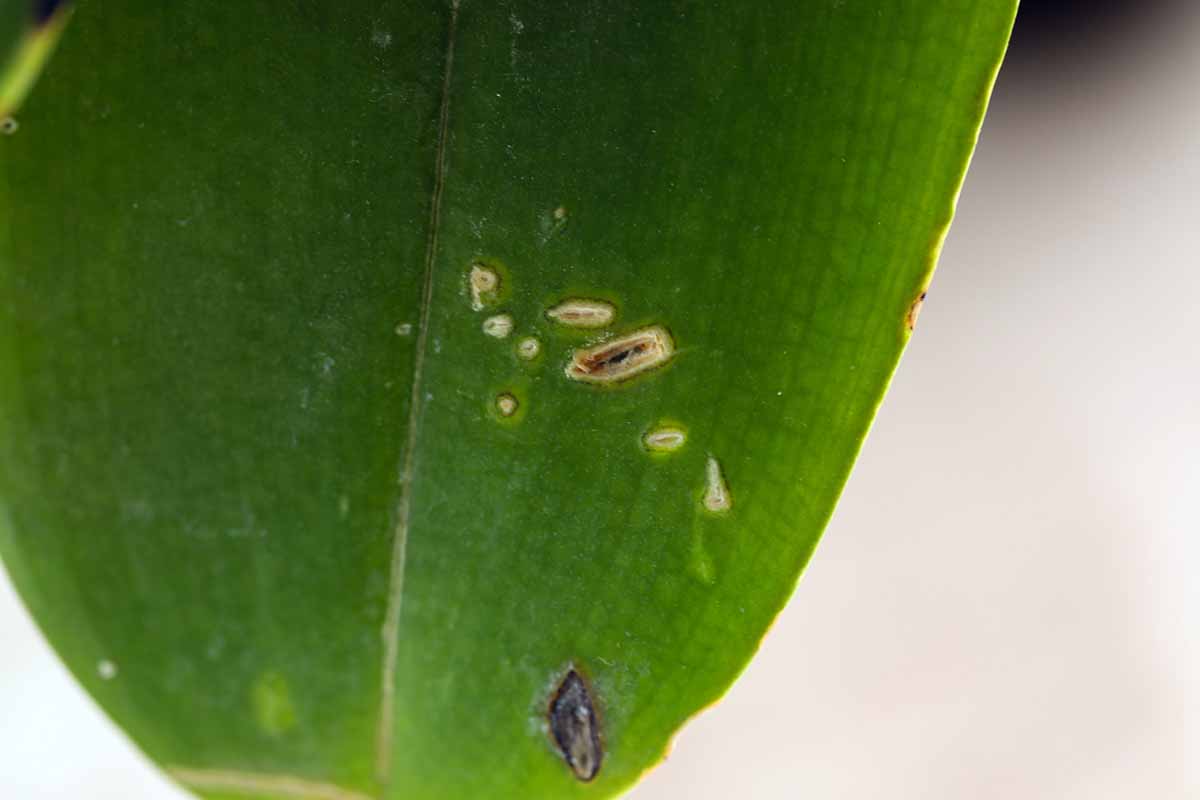
Finally, spots can appear as the result of mechanical damage. These will usually be indented rather than smooth.
I’ve damaged more than one orchid leaf by accidentally knocking it against a stack of books or a cupboard as I move it back and forth to the sink for watering.
The solution here is easy: I should just become a less clumsy person!
10. Strange Patterns
Orchids can be infected with dozens of different viruses, each of which causes unique symptoms.
Odontoglossum ringspot virus (ORSV) and Cymbidium mosaic virus (CyMV) are the most common, but it doesn’t really matter which one (or more) viruses your plant is infected with.
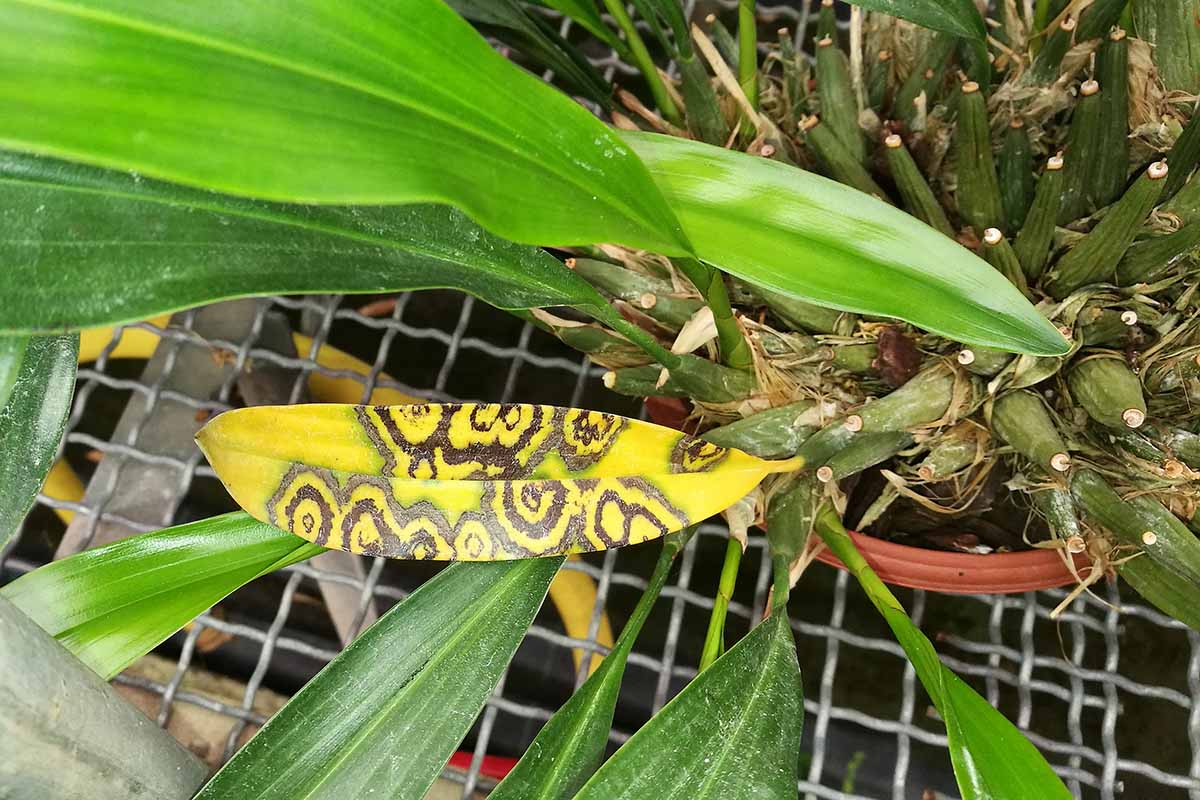
Sometimes, a plant might just seem a bit sad, growing slowly or flowering poorly. Other symptoms can include necrotic spots on the foliage or curled leaves.
But the most obvious symptom of a viral infection is strange patterns on the leaves or flowers. The petals might have broken patches of color or spots and swirls. The foliage can exhibit rainbow-like arches, rings, circles, lines, or splotches of yellow or white.
There is no cure, and the virus can spread to other orchids, so you should either isolate the plant or dispose of it.
11. Wilting
Wilting usually goes hand-in-hand with wrinkling foliage. When it happens, you can be confident that your plant has been chronically over- or underwatered.
Not only is the plant suffering aboveground, but it’s highly likely that things aren’t looking so good below ground, either. Usually, when the leaves are drooping, there is some amount of root involvement.
Regardless of the cause, the problem is the same: the plant can’t take up enough water. Either because there isn’t enough water in the soil, or the roots have been left in too much water for too long, causing them to suffocate.
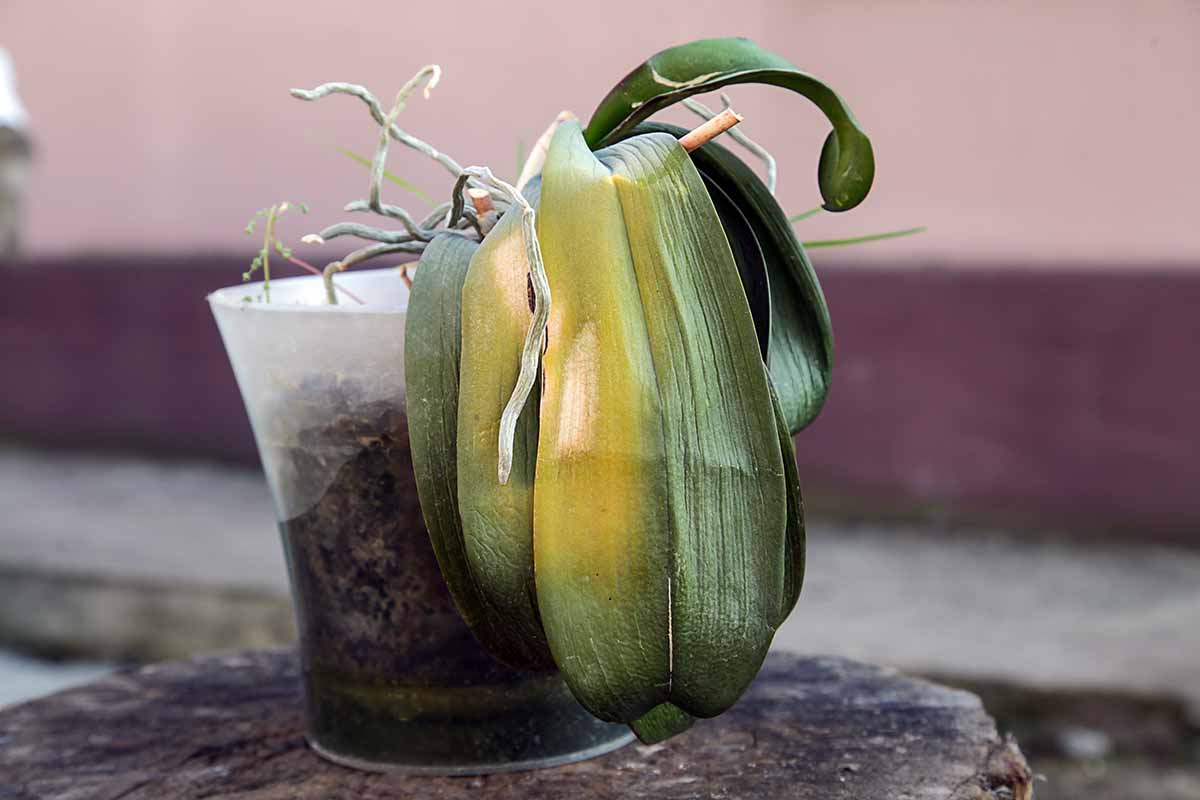
Remove the plant from the pot and knock away the substrate from the roots.
Take a close look at the roots and see what’s going on. If the roots are brown or black and soft, this indicates the plant is being overwatered, and the roots are dying.
If the roots are gray and wrinkled, it means the roots are dry and haven’t had enough water.
If the roots are soggy, trim those all off with a sharp, clean pair of scissors or pruners. Spray the roots with copper fungicide diluted to half strength and repot the plant in a container one size down. Make sure to use a fresh potting medium.
Because the roots are struggling, mist the plant every day for the first two weeks after repotting.
Then, withhold watering at first while continuing to mist to encourage new roots to form and seek out moisture.
After a week, resume regular watering, but be sure to empty any catchment container after 30 minutes and reduce the amount of water you’ve been giving.
If the cause is underwatering, this is a fairly easy fix. Place the slotted inner pot or a container with a drainage hole in room temperature water and allow the plant to soak up all it can for 15 minutes. Then, repot it and start watering more often.
Regardless of which problem caused the drooping leaves, they won’t perk back up once you fix the problem.
With other popular houseplant species, the foliage usually recovers when they have the water they need, but orchids don’t work like that. You’ll have to wait for new growth to form.
12. Wrinkled Leaves
When you see wrinkled leaves, your first thought would logically be that the plant doesn’t have enough moisture, and that might be the case. But it can also be a sign of too much water or symptom of a disease, so don’t jump to conclusions.
The most common cause, absolutely, is underwatering. Wrinkles happen when the tissue doesn’t have enough moisture to plump up the cells. It happens in our skin and it happens in plants.

If you lift up the plant, pot and all, and it feels light, it doesn’t have enough moisture. If you touch the substrate and it feels bone dry, again, it’s too dry.
If your orchid is in a clear pot, examine the roots carefully. If they look healthy, wrinkled leaves are probably indicative of a lack of water.
But if you see black or soggy roots, it’s likely they have rot, and the plant can’t take up water. This is common when a plant is overwatered.
It can also happen when the medium starts to break down, reducing the amount of oxygen the roots can access.
If the plant has root rot, trim off all the sick roots and keep a humidifier next to the plant so that it can gain moisture through the foliage.
Be cautious about maintaining the correct water in the medium as the plant develops new roots.
13. Yellow Splotches
Did you recently move your plant into a brighter location? Or maybe the sun is reflecting off of something and hitting your plant? Yellow splotches on the leaves can point to direct sun exposure.
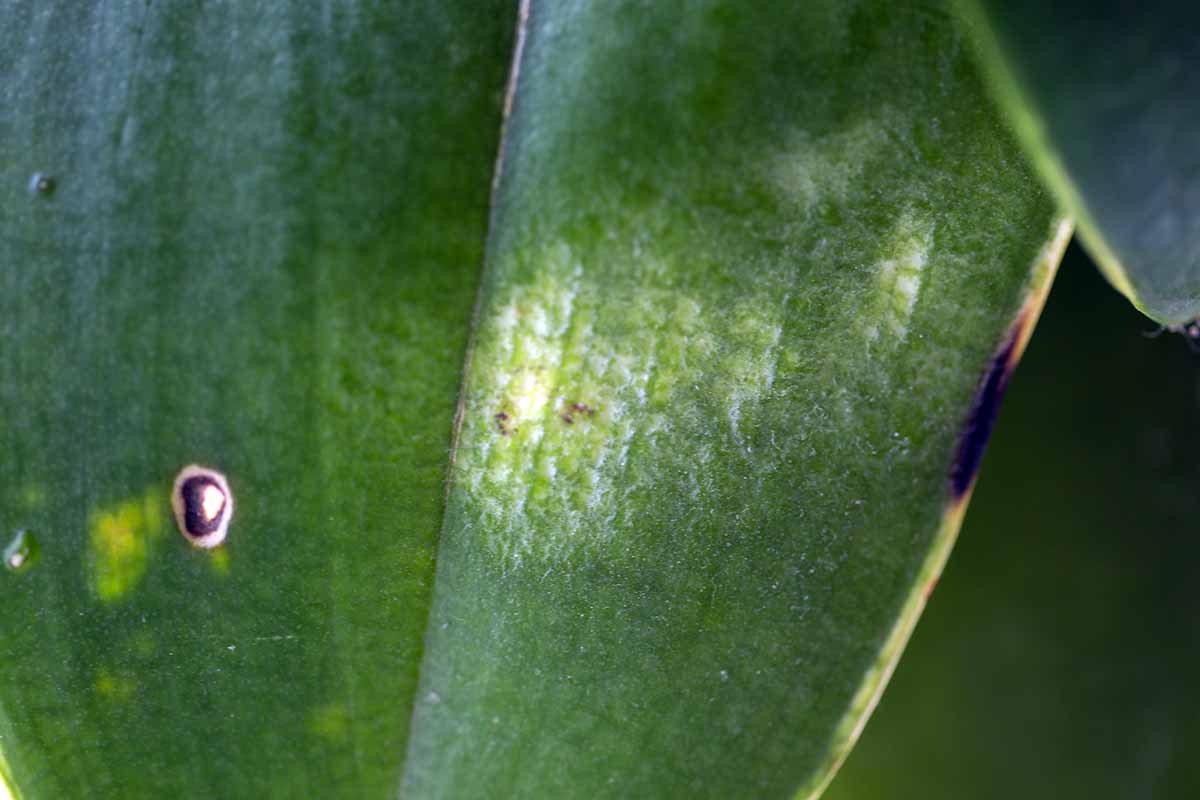
If you leave the plant in the bright light, the yellow parts might even start to develop dark brown areas. It’s as if the leaf is literally being burned.
The fix is easy enough. Move the plant into a location with less light. The affected leaves won’t heal, but new ones will emerge healthy.
Put Those Problems Away
Remember, you need to catch the problem early to give yourself the best chance of fixing it.
Even those incurable issues should be caught fast so you can prevent them from spreading to other plants. Make a habit of examining your plant closely each time you water it.
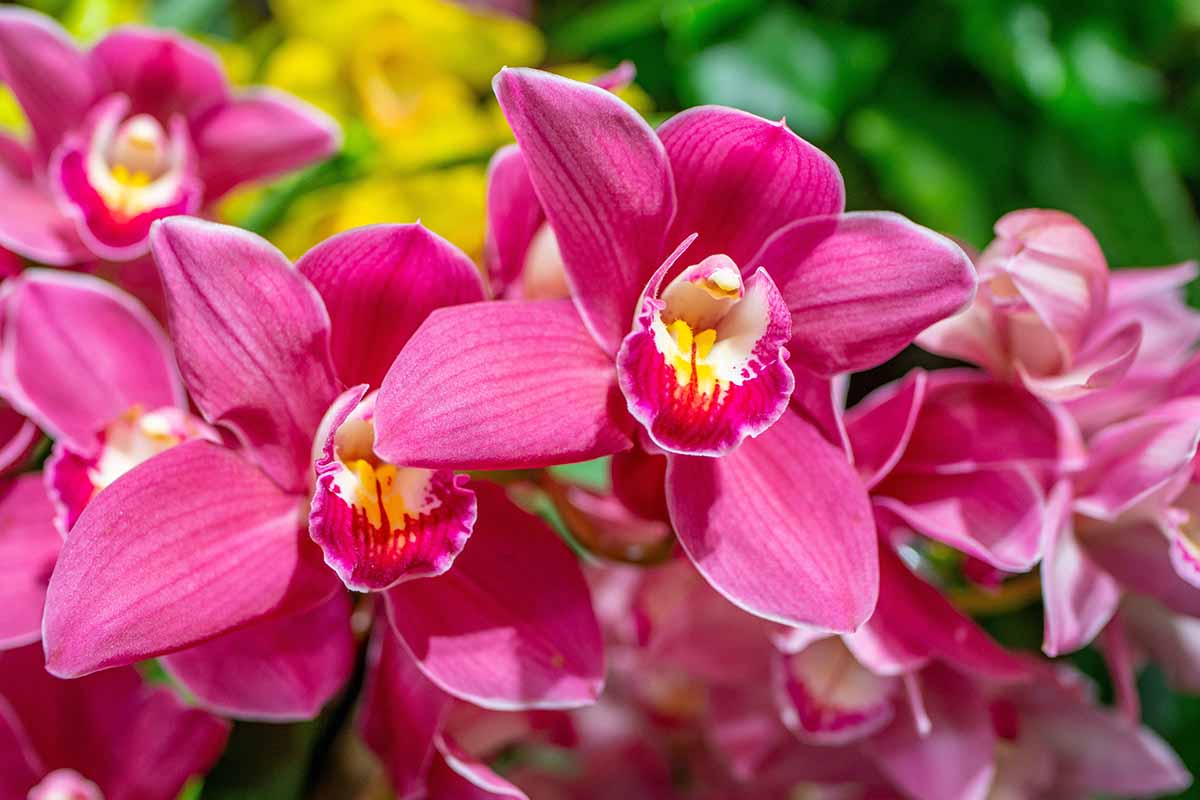
What kind of orchid are you growing and which of the above issues are you seeing? I hope this guide helped you solve it, but if not, let us know what’s going on in the comments section below.
Your orchid journey doesn’t end here. There’s always more to learn about these striking plants. If you found this article useful, then you might enjoy these guides next:
